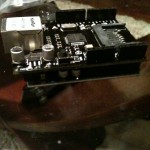I combined the push button example and the tweet library example to create a “twitterbutton” which will tweet a message and alert my iphone when a button is pressed. I needed to get a Auth code from Twitter to allow the Arduino to send a tweet. The instructions are straight forward and are on the Tweet Library page. The alerts are sent to the iphone because I “follow” the twitter account front another account and have it set for mobile alerts. All the testing are under Twitter account settings.
Note: Use a 10k resistor as a pull down for the push button (brown, black, orange, gold).
You will need to get the Twitter Library 1.2.2 and put them in the ~/Documents/Arduino/libraries (Mac) or My Documents\Arduino\libraries\ (Windows). Also, you will need EthernetDNS library and put them in the same folder. Arduino Playground Reference TwitterLibrary.









